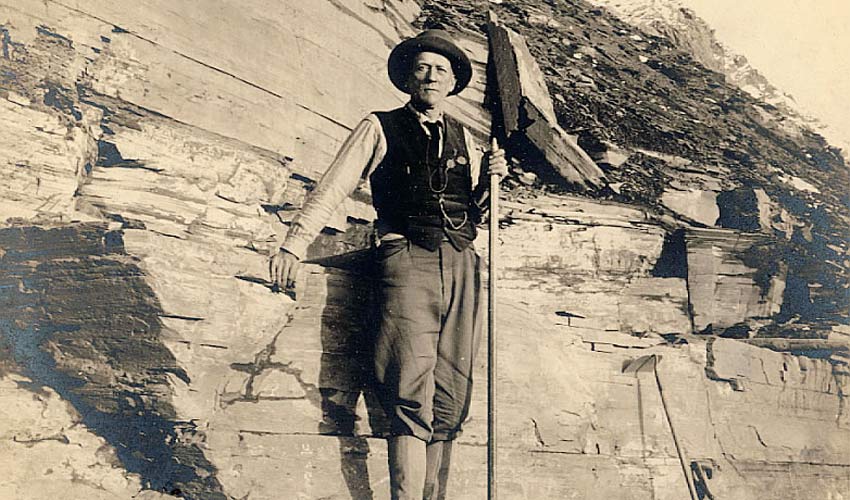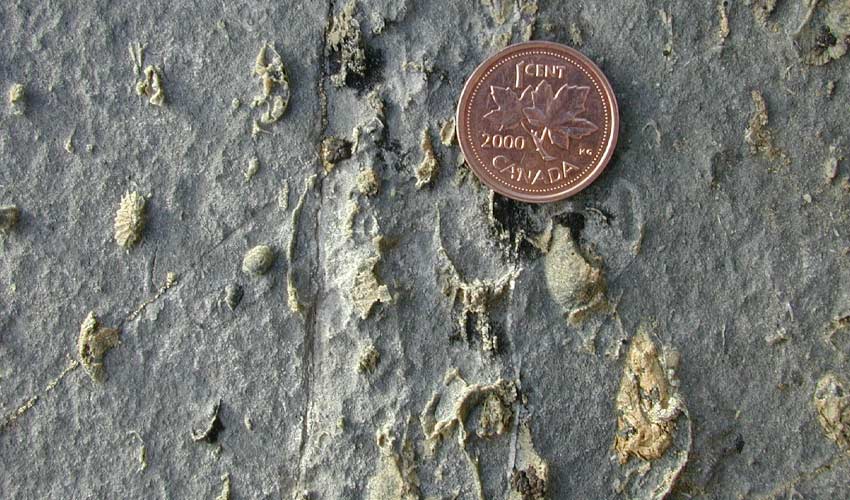Mount Royal University scientist cracks century-old fossil mystery
Dr. Paul Johnston, PhD, has spent decades researching famed Burgess Shale
Canada’s famous Burgess Shale is located on Mount Stephen in Yoho National Park.
Tiny shells discovered by a Mount Royal University researcher in 505-million-year-old rocks dating from the Cambrian Period in southeastern B.C. yield new clues to peculiar animals known as stenothecoids, which have puzzled paleontologists for more than a century.
Dr. Paul Johnston, PhD, an associate professor in the department of Earth and Environmental Sciences at Mount Royal University, made the find in Canada’s famous Burgess Shale on Mount Stephen in Yoho National Park, which contain a collection of marine invertebrates dating from the dawn of complex life on earth considered the world’s most important animal fossils. Johnston’s discovery is an important piece of the Burgess Shale puzzle that illuminates how life evolved on Earth.
Johnston is no stranger to the area, having researched the Burgess Shale on and off since 1996. He has organized several expeditions there, first as curator of invertebrates at the Royal Tyrrell Museum and later as a faculty member at MRU. He’s authored or co-authored seven papers on the topic, edited a book, presented 26 conference talks, and co-supervised two graduate student theses. While at the Royal Tyrrell, Johnston conceived and developed the exhibits on the Burgess Shale. He also led guided hikes to the area for the Burgess Shale Geoscience Foundation in Field, B.C.
Previous researchers focussed on splitting shale to expose well preserved but flattened specimens. Instead, Johnston examined nearby limestone layers and found three-dimensional shells of the mysterious stenothecoids. The problem was how to extract the delicate centimetre-sized shells from the hard encasing limestone.
“I could see with my hand lens that the stenothecoid shells had been replaced by silica during their half-billion year entombment, and so I could dissolve the limestone with acid in the lab to extract the shells,” Johnston says. “The results were excellent.”
Finding the right family at long last

Charles Walcott, Secretary of the Smithsonian Institution Washington D.C., first discovered stenothecoids in Nevada but became famous later with his discovery of the Burgess Shale in 1909.
Johnston likens the find to a “fun paleontological detective story.” Since first discovered in Nevada in 1884, stenothecoids have been found in Cambrian rocks in diverse places around the globe including Australia, China, Siberia, Greenland, Newfoundland, Alaska and Western Canada, he says. But, interpretations of the stenothecoids have varied widely. Researchers have classified them in four different phyla, which provides an indication of the range of disagreement, although most considered stenothecoids to be an extinct group of molluscs, a hypothesis that turned out to be incorrect. Stenothecoids survived for about 25 million years, the Burgess Shale examples being among the last.
“During the time of the Burgess Shale, North America straddled the equator. What is now the west side faced north, and most of British Columbia didn't exist at all,” explains Johnston. “The continent ended about where Revelstoke is, and the stenothecoids I studied inhabited a limey tropical sea.”
Stenothecoids have perplexed paleontologists because of their odd combination of shell features, which do not match any of the major groups (phyla) of modern shelled animals. Like clams, the stenothecoid shell comes in two parts, known as valves, but with one valve more inflated than the other they are therefore unlike the equally convex valves of early clams. Taken individually, the valves of stenothecoid shells are asymmetrical, and so don’t match the other major group of duo-valve shelled animals in Cambrian seas, the phylum Brachiopoda, which invariably show symmetrical valves.
This led most researchers to conclude that stenothecoids must represent an extinct group of the phylum Mollusca, which today includes creatures such as clams, snails, and squid. Some Russian researchers even proposed that stenothecoids represent their own extinct phylum. However, Johnston’s find shows that stenothecoids possessed a previously undetected small opening at the apex of the shell like that in the phylum Brachiopoda, which include living members that use the hole as an exit for a unique stalk that attaches them to the seafloor.
With that realization, Johnston teamed up with brachiopod expert, Michael Streng at Uppsala University, Sweden. Together they proposed that stenothecoids were an early evolutionary off-shoot from tubular Cambrian animals known as eccentrothecimorphs, which show multiple asymmetrical valves and that ultimately gave rise to brachiopods that survive in modern oceans.
Spreading the word of the stenothecoids

This is how the fossils appear when exposed on the limestone surface.
Johnston and Streng’s study appeared online in the journal Acta Palaeontologica Polonica. Their work was funded by grants from the Natural Sciences and Engineering Research Council of Canada, Mount Royal University Faculty of Science and Technology, and the Swedish Research Council. The newly described Burgess Shale fossils will reside in collections of the Royal Tyrrell Museum in Drumheller, and the Royal Ontario Museum in Toronto.
“The Burgess Shale represents one of the most diverse and well-preserved fossil sites in the world, is a UNESCO World Heritage Site, and is exceptionally valuable to science,” says Dr. Jonathan Withey, DPhil., dean of Science and Technology at MRU. “To have this close by, and to be able to facilitate access for faculty and students, provides a remarkable opportunity for research and teaching in paleontology.”
Johnston is past editor of Palaeontographica Canadiana, Canada's national monograph series on paleontological research. An internationally recognized expert on the evolution of bivalve mollusks (clams, oysters, and scallops), his research has taken him to diverse regions of the planet including remote areas of the Rocky Mountains, Arctic Canada, Patagonia, the Gobi Desert, Australia and the Philippines.
What’s so great about the Burgess Shale?
Great Age: The Burgess Shale is middle-Cambrian in age (~505 million years old), which falls within an interval known as the "Cambrian Explosion" when most of the basic animal lineages (phyla) were first evolving and diversifying. The Burgess Shale provides an exceptional window into this critical interval of animal evolution.
Great Preservation: The Burgess Shale has revealed much about the early evolution of animals and their evolutionary relationships, largely owing to the exceptional preservation of the fossils. The fine-grained shales preserve details of soft part anatomy such as digestive tracts, eyes, gills, etc., that are almost never preserved in fossils and that offer unique clues to the genealogical relationships among animal lineages. The shells Johnston found occur in limestone beds within the Burgess Shale that do not preserve soft-part anatomy, and so have been little studied.
Great Disparity: Disparity means not just diversity (i.e., the number of different kinds) but the range of anatomical constructions. An extraordinary aspect of the Burgess Shale is that it has yielded many animals with body plans that do not fit easily into any of the major animal groups (phyla) recognized today.
Read more about the impact of inquiry and discovery at Mount Royal University.
Read more about MRU’s Faculty of Science and Technology.
Jan. 19, 2022 — Peter Glenn
Media request contact information.
Have a story idea? Please fill out this form.

